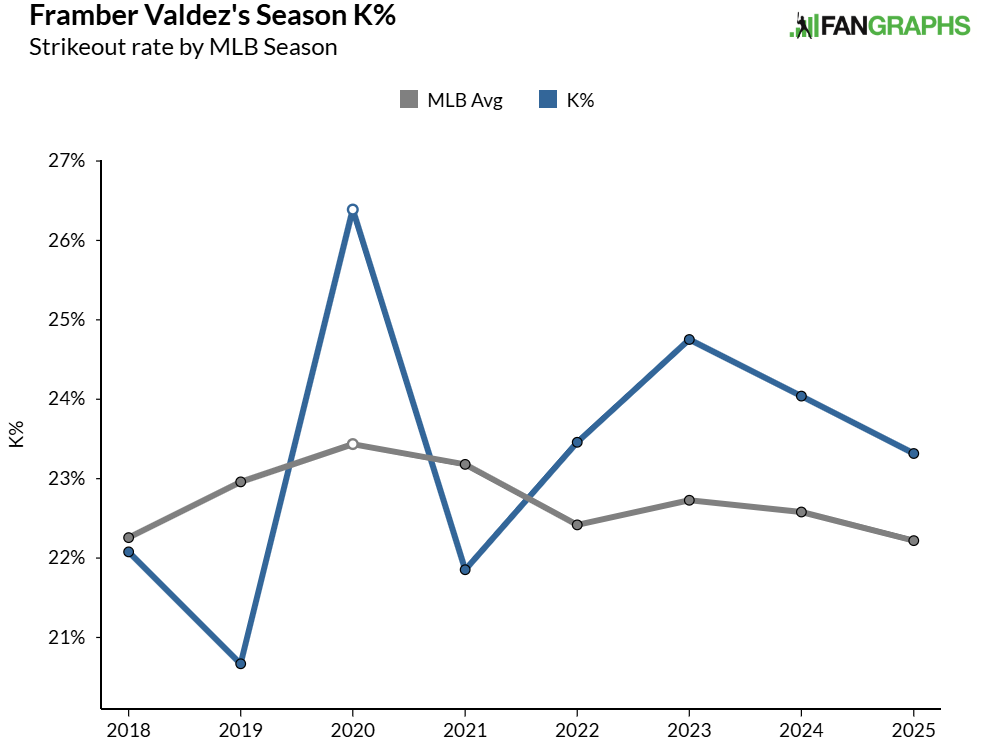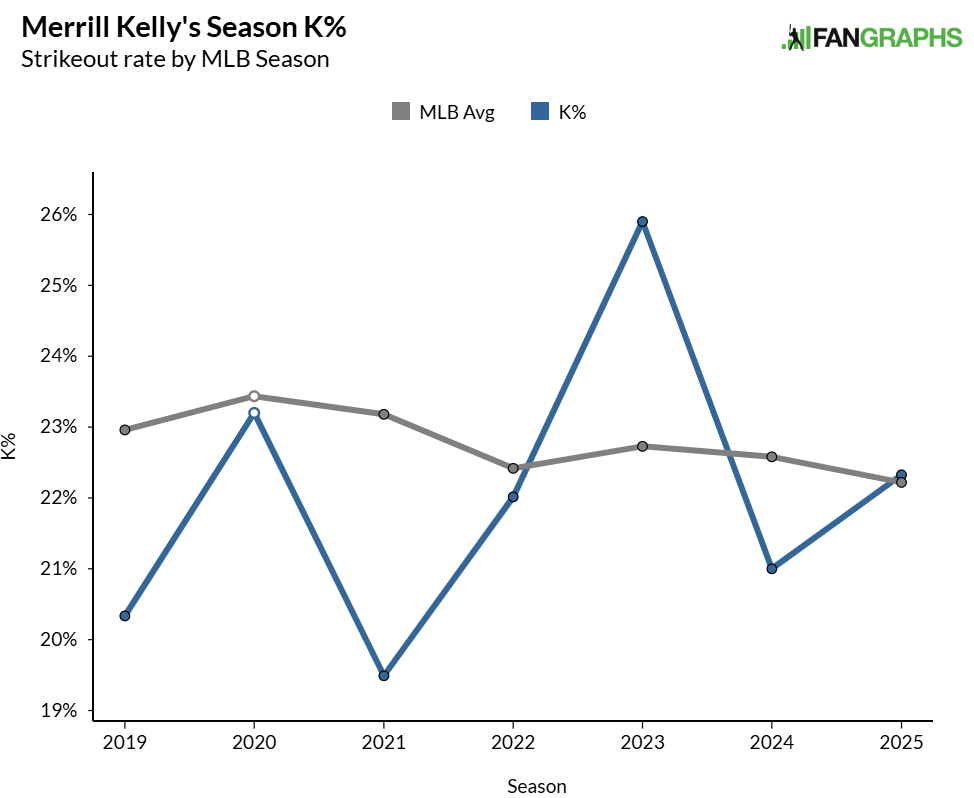
Good pitching never goes out of style.
It’s not easy to get either, as injuries can derail even the most promising pitching prospect’s career and developing arms internally is a perilous and often frustrating business.
The best franchises still try — and often succeed — with this difficult task, but there is a strong appeal to acquiring veteran pitchers who have already shown themselves capable of handling the rigours of pitching at the highest level year after year.
This off-season, there are several strong options for teams looking to boost their pitching staffs through free agency:
Framber Valdez
Age in 2026: 32
2025 fWAR: 4.0
Role: SP
Outlook: In the last four seasons, Valdez ranks second in the majors in innings pitched (767.2) and fifth in fWAR (16.5). The southpaw’s durability, efficiency and ability to generate ground balls are all elite.
While he doesn’t rack up strikeouts like some front-of-the-rotation starters, he’s not late-career Mark Buehrle, either. He throws in the mid-90s and tends to put up a strikeout percentage one or two points above league-average.
His statistical profile screams safe bet, even if a bizarre late-season incident where he hit his catcher in the chest with a pitch in what some saw as an intentional cross-up — a notion Valdez later denied — raised some eyebrows.
Ranger Suárez
Age in 2026: 30
2025 fWAR: 4.0
Role: SP
Outlook: Suárez isn’t a true front-of-the-rotation workhorse, but he reliably keeps runs off the board. Of the 58 pitchers who’ve logged 600 or more innings over the last five seasons, his 3.28 ERA ranks 10th — and it was an even better 3.25 in 2025 with strong underlying numbers (3.15 xERA).
He’s also been an unbelievable post-season performer, with a career 1.48 ERA in 42.2 innings, and he’s younger than most of the alternatives on the market.
The biggest red flag with Suárez is his fastball velocity, which has dipped in recent years. It’s impressive that the lefty was so effective with a 90.1 m.p.h. sinker in 2025, but the fact that it’s dropped from 92.8 m.p.h. in 2023 has to be concerning for some teams. He clearly doesn’t need to be a fireballer to succeed, but stopping the bleeding on the velocity loss will matter.
Dylan Cease
Age in 2026: 30
2025 fWAR: 3.4
Role: SP
Outlook: Cease is coming off a peculiar season with far better underlying numbers (3.46 xERA and 3.56 FIP) than results (4.46 ERA).
That won’t discourage suitors too much, as the right-hander is coming off his fifth consecutive season with at least 32 starts made, 165 innings pitched and 214 or more strikeouts. If you take the ball every fifth day and miss bats at an incredible rate, you are going to be highly valued.
Cease is not without his blemishes. Control can be a struggle, he’s imploded in most of his post-season opportunities and 2025 isn’t the only season when his run suppression hasn’t met expectations. He enters free agency coming off two seasons with an ERA over 4.50 in his last three.
Tatsuya Imai
Age in 2026: 28
2025 NPB stats: 1.92 ERA in 163.1 IP with 178 strikeouts and 45 walks
Role: SP
Outlook: Despite his small frame (five-foot-11, 154 pounds), Imai throws in the mid-90s, with a wipeout slider to use as a strikeout pitch.
His control has improved significantly in his mid-to-late twenties, and he’s logged at least 150 innings in four of the last five seasons. While a smooth adjustment to the majors is never a guarantee, plenty of teams will see Imai as an immediate rotation contributor who could become an impact arm.
Michael King
Age in 2026: 31
2025 fWAR: 0.8
Role: SP
Outlook: King wasn’t a full-time starter until his age-29 season in 2024, but when he got that chance he ran with it, posting a 2.95 ERA over 173.1 innings — good for the 13th-best fWAR among all pitchers (3.9).
Last season was less of a triumph as the right-hander endured both shoulder and knee injuries, limiting him to 15 starts. In those outings, he still managed a 3.44 ERA, but struggled with home runs at times (1.47 HR/9).
King doesn’t have a lengthy track record, but his 3.10 ERA over the last two seasons is backed by an impressive strikeout rate (10.02 K/9) driven by a pair of excellent secondary pitches that break in different directions.
He can be a top-of-the-rotation presence when healthy, and that type of ceiling isn’t easy to find on the free-agent market.
Edwin Díaz
Age in 2026: 32
2025 fWAR: 2.0
Role: CL
Outlook: Relievers are notoriously fickle, but Díaz has been trustworthy for a long time, despite having a single off-year back in 2019, and missing 2023 to a patella tendon tear.
Since he debuted in 2016, the right-hander leads all relief pitchers in fWAR (15.4), and he’s been especially good recently, posting two or more fWAR in three of his last four seasons, with two campaigns sporting an ERA below two.
His K/9 has never dropped below 12.14, and his average fastball velocity has topped 97 m.p.h. each year. That number isn’t as impressive as it once was, but it plays when you’ve also got a slider that’s generated 192 Ks in your last three seasons.
The most likely scenario here may simply be Diaz re-signing with the Mets, but another team might take a shot at acquiring one of MLB’s top relief aces.
Justin Verlander
Age in 2026: 43
2025 fWAR: 2.2
Role: SP
Outlook: Verlander is a somewhat sentimental addition to this list, but he’s coming off a 2025 campaign that suggests he has more to offer an MLB team than veteran wisdom in the upcoming year.
The quadragenarian managed a 3.85 ERA (backed by a 3.85 FIP and 4.21 xERA) in 152 innings in his age-42 season, and finished strong with a 2.99 second-half ERA.
Verlander’s fastball velocity fluctuated quite a bit on a month-to-month basis and declined from its peak in July (94.9 m.p.h.) to a less impressive 93 m.p.h. in September. That kind of late-season sag is possible again, but there are some green flags here too.
Midway through 2025, Verlander added a sweeper to his arsenal that missed bats (27.5 per cent whiff rate) and generated weak contact (.138 xBA), and it could be a bigger part of what he features in 2026. His overall arsenal also graded highly by stuff+ (106), even topping his 2023 (105) — a season where he managed a 3.22 ERA.
Zac Gallen
Age in 2026: 30
2025 fWAR: 1.1
Role: SP
Outlook: Gallen is a puzzler. Between 2022 and 2024, his 12.2 fWAR ranked seventh among all pitchers, and he earned two top-five finishes in Cy Young voting.
The left-hander looked like he was on his way to a colossal payday until he produced a truly uninspiring 2025 that saw his ERA balloon to 4.83 while his strikeout rate dipped and home runs became a major problem.
His velocity remained approximately the same, the movement on his pitches held relatively steady, and even his command seemed solid as his location+ (105) even ticked up from his excellent 2024 (104).
Even though he wasn’t particularly effective, the left-hander still pitched 192 innings, and his second-half ERA (3.97) was far better than his first-half number (5.40). Considering Gallen’s age and pedigree, there will be plenty of teams believing they can help him bounce back.
Robert Suarez
Age in 2026: 35
2025 fWAR: 1.9
Role: CL
Outlook: Suarez doesn’t have Díaz’s resume, and he’s no spring chicken, but he’s one of the scariest relievers in the game right now.
Over the last two seasons, his 76 saves led the majors, and his average fastball velocity (98.9 m.p.h.) lags behind only Mason Miller, Jhoan Duran and Ryan Helsley. He throws four-seamers and sinkers more than 75 per cent of the time, but hitters cannot seem to adjust.
Suarez is the type of reliever you can feel comfortable about handing the ball to in a one-run playoff game, and multiple contenders will see him as a definitive back-of-the-bullpen solution.
Merrill Kelly
Age in 2026: 37
2025 fWAR: 3.1
Role: SP
Outlook: Kelly is old, doesn’t throw hard, and isn’t the kind of household name that will electrify a fanbase when he signs.
What he does is keep runs off the board. In three of the last four years, he pitched between 177.2 and 200.1 innings with an ERA between 3.29 and 3.52, producing a fWAR of either 3.1 or 3.2. The 2024 season that broke up that consistent flow included a shoulder injury that put him on the 60-day IL in April, but he was still able to return and deliver a respectable 4.03 ERA in the limited campaign.
Kelly’s overall effectiveness has been stable into his late thirties, but his strikeout rate has fluctuated quite a bit.
He can’t be counted on to miss as many bats as some other free-agent starters, making him more of a fit for teams that can put some solid defensive players behind him.








